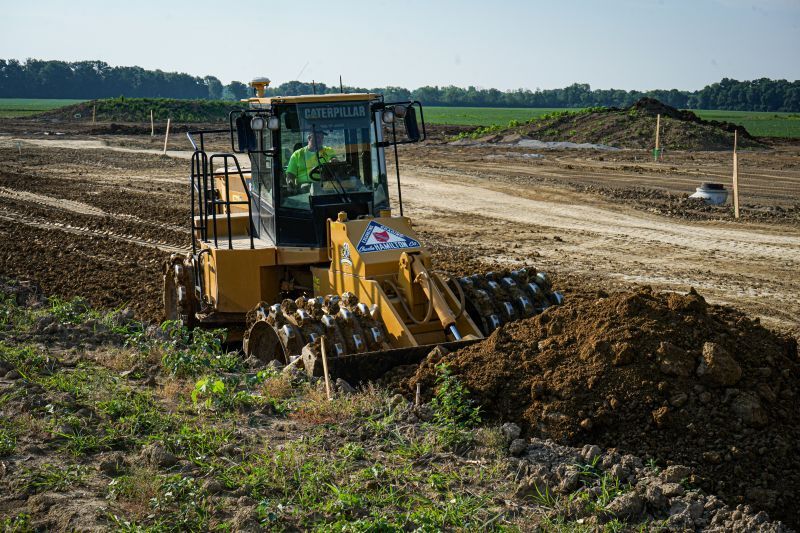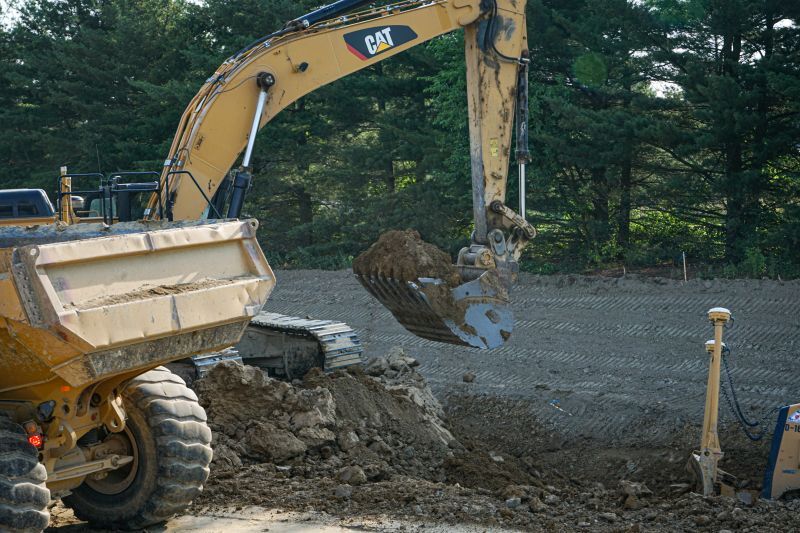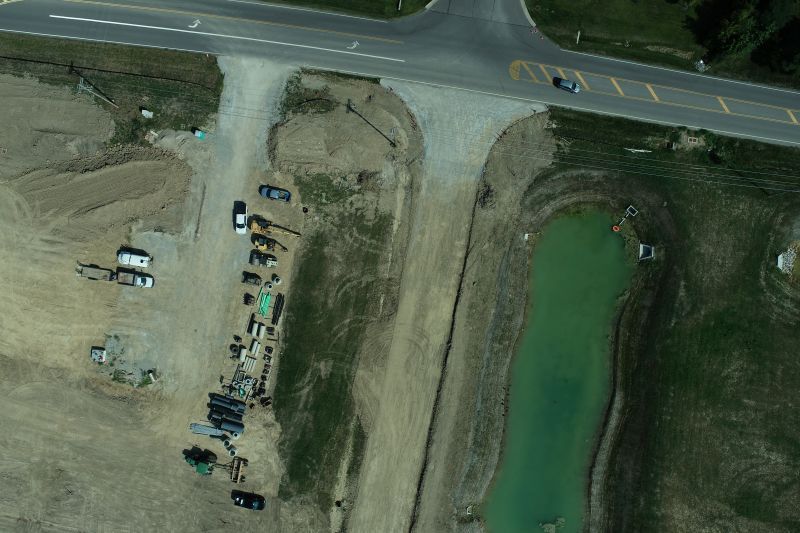How Developers Can Prevent Road Failure with Proper Compaction
.jpg)
Before sunrise, the crew checks moisture at the cut line. A roller idles nearby. Survey stakes mark grade, and the first pass tells the truth: the ground either tightens under the drum or it moves. That moment decides how the road will perform.
Understanding what happens in that moment explains why some roads last for decades while others start breaking down before the first winter. Compaction defines everything that follows. It shapes the strength of the base, the smoothness of the surface, and the long-term cost of maintenance.
When the subgrade and base support the load and shed water, the surface rides well and schedules stay on track. For teams planning road construction that needs to last, compaction is not a box to check. It drives everything that follows.
This guide breaks down how compaction determines road performance, what best practices keep projects on track, and how developers can protect their investment long before paving begins.
How Compaction Determines Road Performance
Subgrade and base layers carry the load. When crews compact the soil, they press the particles closer together and close the gaps between them. That tight structure gives the ground strength to hold shape under traffic and resist deformation.
Drainage and density work together to control long-term stability. A compacted layer has fewer air pockets, which limits how much water can enter and move through the soil. That makes it harder for moisture to weaken the base or for frost to lift and break the pavement. When compaction is uniform, the whole section carries weight evenly and stays stable in wet or freezing weather.
Poor compaction leaves hidden voids that behave differently under pressure. Those soft spots flex and settle, causing stress to build in the layers above. Over time, the surface starts to crack, rut, and separate as the base shifts underneath. A dense, well-compacted foundation spreads every load, protects against water damage, and keeps the pavement performing as designed.

Best Practices for Roadway Compaction
Every strong road starts below the surface. Compaction is not one step of the job; it is a rhythm that runs from grading to final inspection. Getting it right means understanding how each phase builds on the last and what can go wrong if one layer is rushed.
The subgrade sets the tone for everything above it. It carries the load and keeps the base from shifting or trapping water. When the subgrade is compacted correctly, the base can perform the way it was designed.
- Crews compact the subgrade to target density before placing base stone.
- Smooth-drum rollers work best on granular soils, while padfoot rollers reach deeper into cohesive material.
- Consistent moisture and tight compaction hold grade and reduce settlement and reflective cracking.
Building in Layers
Each lift should behave like part of the structure, not a loose layer. The right thickness, moisture, and density make that possible.
- Thin lifts crumble under the roller; thick lifts trap voids that weaken the base.
- Moisture controls how soil responds to compaction. Too wet and it pumps; too dry and it resists.
- Crews test, roll, and retest each lift before moving forward to build a stable, uniform platform.
Checking Strength Before Paving
A proof-roll shows whether the base can carry traffic and asphalt without shifting. It is one of the quickest ways to confirm that compaction holds where it matters most.
- A loaded truck or roller crosses the grade while crews watch for flexing or movement.
- Any soft spots are rebuilt and compacted in lifts until the surface stays firm.
- A clean pass gives inspectors visible proof that the base is ready for the asphalt paving process.

Protecting What’s Underground
Utility trenches can turn a solid road into a patchwork if they are not handled with care. Consistent compaction during backfill keeps the surface even and the drainage path intact.
- Material is added in small, even lifts, compacted and tested as it is placed.
- Matching density with the surrounding base keeps the section smooth.
- When this step is rushed, dips, cracked joints, and early repairs follow.
Working with the Weather
Compaction depends on conditions. Rain, heat, and freeze cycles all affect how the soil reacts under pressure. Crews who plan around the weather protect both progress and performance.
- After rain, layers may need to be dried, blended with drier aggregate, or stabilized with lime or cement.
- In colder weather, finished sections are covered or sealed to hold strength.
- Timing the work to the forecast keeps production steady and reduces rework.
The Role of Testing and Documentation
Compaction only works when it’s measured. Field density and moisture tests confirm that each layer meets spec, while documentation shows how the work was done and protects everyone during inspection. Together, testing and recordkeeping prove the road has the strength to perform as designed.
Crews run field tests as the work progresses, not after the fact. These readings show if the soil is tight enough or needs another pass. Organized results, moisture records, and proof-roll notes give engineers and inspectors a clear picture of progress and build confidence the surface will stay stable under load.
Accurate records make closeout easier. They confirm compliance, support pay applications, and answer questions about how the work was performed. On DOT construction projects, clear reports keep schedules moving and reduce disputes.

Frequently Asked Questions
These common questions come up on nearly every job. Here’s how to handle them in the field.
What density targets should I specify?
Here’s the rule of thumb. Most roadway projects call for around 95 percent of maximum density on both the subgrade and base. The right number depends on soil type, expected traffic, and drainage design. Keep testing consistent across the site and make sure results are verified before the next layer is placed.
How should I deal with wet, pumping subgrade?
That depends on soil conditions and schedule. Don’t build over wet material. It loses strength and traps water beneath the surface. Crews can dry it out by scarifying, mixing in drier aggregate, or undercutting and replacing weak sections. Geotextiles, lime, or cement can also help stabilize soft areas so compaction can continue.
Is cement or lime stabilization worth it for the schedule?
It can be. When weather or soil conditions slow production, stabilization helps reach density faster and keeps work moving. The material cost is higher, but the time savings and long-term performance often make up for it. Evaluate it early so you can plan around curing time.
How much asphalt do I need?
Here’s the general guideline. Thickness depends on traffic, climate, base strength, and layer sequence. A solid, compacted base usually allows for fewer asphalt lifts because the structure underneath carries the load. Confirm quantities after proof-rolling shows the base is uniform and stable.
Build Longer-Lasting Roads with Charles H. Hamilton
Roads that last start with steady work in the ground. When crews compact carefully, verify density, and protect the base from moisture, the surface holds up and the schedule stays on track. Compaction is more than another task on the checklist. It is the foundation of performance.
In southwest Ohio, our team builds roadways with that focus every day. We shape subgrade, control drainage, and compact in lifts that meet specification and inspection standards. We coordinate curb and paving partners through our Premier Curb division so each step supports the next without delay.
Contact us today to start your roadway project with a team that builds for long-term performance.

